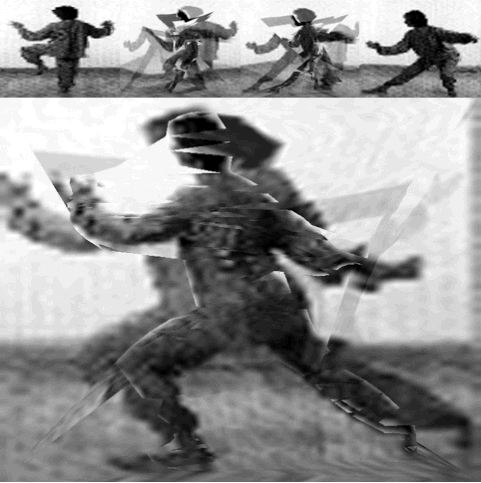

What do you show on these photos – looking like cut up silhouettes or torned shadow tissues, and what is your T'ai Chi TV project about?
Using a series of found T'ai Chi photographs from a Chinese web site, I had made a black and white mute animation film. I was looking then for someone practising T'ai Chi; I had this idea of a performance including the projection of the animation film and a real person performing T'ai Chi at the same time in a kind of double-exposure. I asked everyone I met if he or she knew somebody, but no one seemed to be into T'ai Chi, so I just phoned the first person I found on a web site with a list of T'ai Chi teachers around Antwerp where I am staying now…
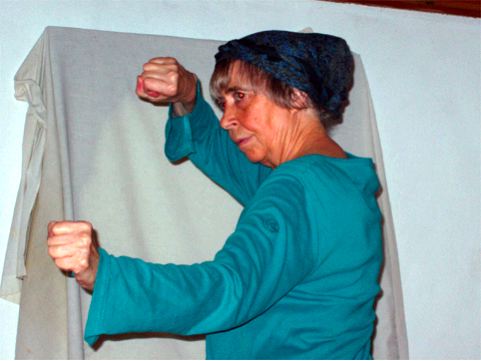
You found this charming lady…
I was very lucky to get in touch with Jen Eijssen. Our first contact was really funny because when I called her I expected a man (I thought Jen was a man's name); and she told me immediately that she's a very old woman and that I probably would prefer to work with a young woman instead. – She loved the idea at once, and we met the same evening at her T'ai Chi classroom.
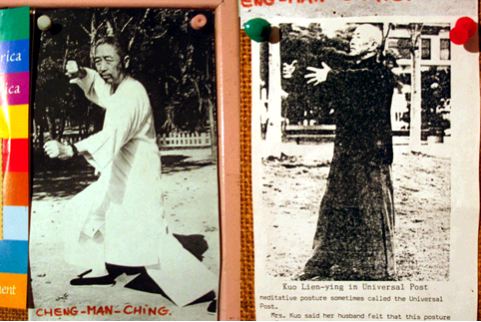
What about your idea of working with T'ai Chi, did you know anything about that kind of practice? And could you tell how you became interested in the making of that film?
Actually, I had no idea what T'ai Chi is when I made the animation film. I just liked all the small black and white photographs of different sequences of T'ai Chi movements on the Chinese web site I had landed on by chance. The first time I met Jen at her studio, she invited me to join her class. She said that if I wanted to make something with T'ai Chi, it was important for me to know what it is all about. Jen teaches the Yang style developed by the master Cheng Man Ch'ing and by his predecessor Kuo Lien-Ying. So I practiced in her class, and I liked it. Yet, the gestures were very slow, my film was much faster, and I told her that this might be a problem for the performance. But she explained that you can practise T'ai Chi as fast as you want and showed me a very fast variation. Both of us still thought that it was better to do it slowly in the show, to keep the speed of Jen's performance independent from – and thus asynchronous to – the speed of the film.
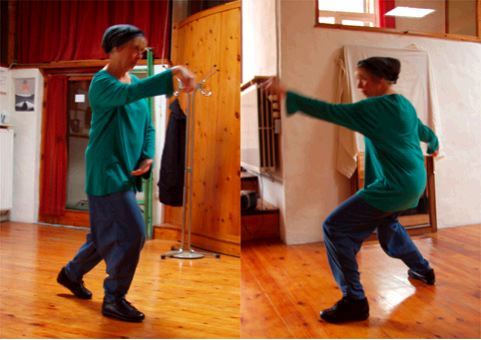
Your cooperation worked very well right from the beginning?
I was very surprised that Jen understood the project immediately. She was also familiar with all the terms like "performance", "project room", "documentation", etc. At the end of our first meeting she confessed that she had been studying visual arts from 1959 to 1963 but, due to personal reasons, she had abandoned art in favour of T'ai Chi… At our second meeting, when I made some photos of her "in action", I asked her if she had some old photos or other documents dealing with her relation to T'ai Chi. With regard to this, she told me that she actually likes to make small drawings of T'ai Chi movements and poses, just small sketches and studies. Of course, I was very eager to see them, and I asked her if she would like to show them in the exhibition. We agreed that she would bring them for our third meeting.
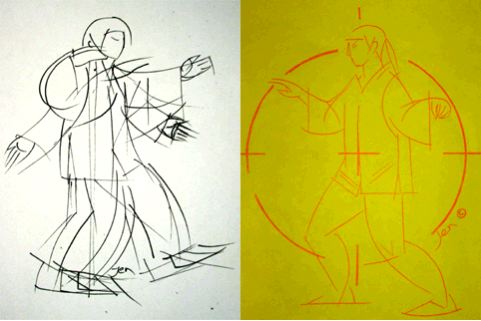
Did her presence as a former artist and a practitioner of T'ai Chi - and as your performer and "model" - deepen your initial idea, or did it change the project somehow?
Yes, initially I just wanted to find someone who would accept to make a short T'ai Chi demonstration at the opening of the group show at Factor 44, an alternative art space in Antwerp. Thanks to Jen, I started to become more and more interested in the whole process that preceded the show. I told her this and she understood it and agreed to expand our collaboration in order to document the process leading to the performance – using the documentation as an artistic medium in itself. Nevertheless, she changed her mind concerning the drawings. She didn't bring the original ones but she brought photocopies of them, telling me that she didn't like the idea of showing the originals in an art context… She explained that - although they would have been only a part of the show and the documentation - people would still have looked at them as being "THE Works of Art". And she was very right about that, so we decided that I could use her photocopies to work with them if I wanted.

What would you emphasise concerning your dialogue on art in your mutual work?
For me it was astonishing how intuitively Jen made (right) decisions about what and how to show; about what she liked or disliked in the project. For instance, she said that she really likes the sound of a film projector and the idea of performing to this sound. Since she was a bit disappointed when I told her that it was a DVD format and that video projectors don't make that kind of sound, I went home and found a cinema's projection rooms' sound in the internet that I added to the computer animation. And it fitted perfectly! It made the video more interesting because the black and white images slip into a strange "in-between époques" dimension of old fashioned black and white movies with time-synchronisation problems and of digital imagery that doesn't try to hide it's digitalness.
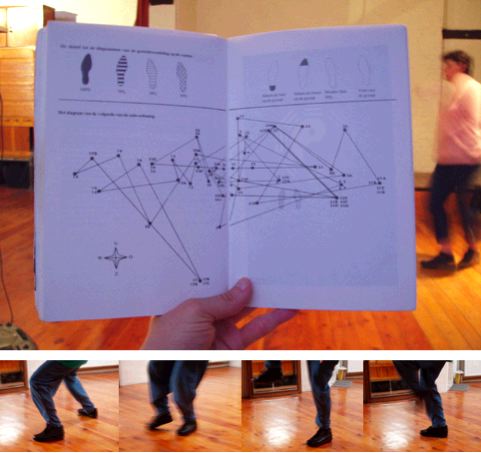
Was there any moment when her practice of T'ai Chi revealed something unexpected?
When I photographed her while she was practising, she insisted on the importance of footwork in T'ai Chi. She told me I shouldn't concentrate on the upper body but on the movements of waist and feet. At our next meeting, she brought me a book, showing complex diagrams of feet movements in T'ai Chi. I guess this changed my understanding of T'ai Chi and made me look at it differently.
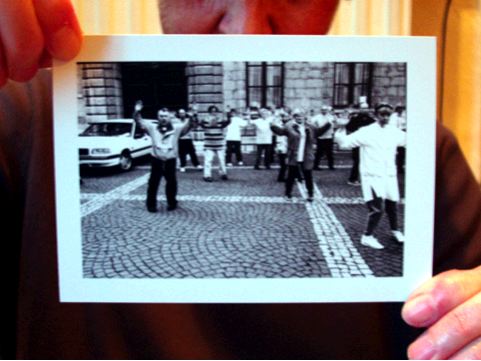
Speed and sound are important phenomena in this work. Could you tell more about the visuals?
Jen was very interested in the photos I took of her while she was practising, and she brought some old black and white pictures, showing her with her class performing outdoor on a parking lot in the middle of the city of Antwerp. She didn't like those photos very much because, in her opinion, she looked like a baker in those white clothes, but she still agreed to let me photograph them because she thought they were funny. I was totally excited about them, of all those people in normal clothing making a strange choreography on a parking lot.
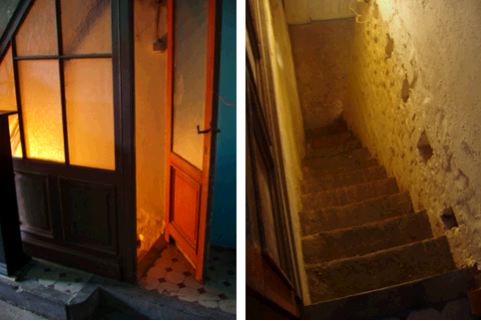
Was there any improvisation or contingency in your production, or do you see the preparation as a quite structured work?
We couldn't work at the exhibition place until one week before the show. So we kept on meeting every week at her class, exchanging ideas and material. Jen really took a lot of interest in every detail of the preparation, asking about the light, how many people would assist to the performance… And she was especially pleased with the space I had chosen for the work: A small cellar that you enter through a tiny door. The cellar is divided into two spaces, we had one for the public and one for her and the projection. There is a rectangular cutting in the wall between the two spaces, that I transformed into a kind of TV screen, so the audience was put in a situation of "watching T'ai Chi on TV", and Jen had more privacy for her performance. – Our numerous meetings, and the fact that we couldn't actually "rehearse" the performance until shortly before the opening, transformed the preparation itself into the subject of our work. New elements entered into the work every time we met.
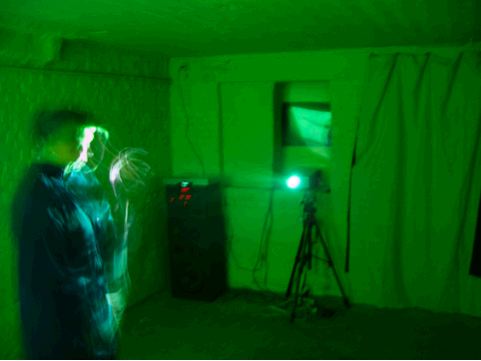
If you regard the preparing process as being the actual work of art, too, what was the meaning of the final installation and the performance?
Well, I think the installation and the final performance also became part of the preparing process. Of course they existed as an "autonomous artwork" during the exhibition, but for me their essential function was to be part of – and the trigger to – this whole research and dialogue process, especially with Jen, but also with you in this interview. – As I said, the idea of the performance – that necessitated some kind of installation – was the starting point for it all; and also the goal of the process. So it's not about making a documentation for the sake of a documentation. It's more about expanding the work by revealing the research process. It's also about inscribing the work into a narrative. For some reasons, I always remember a story that I heard when I was an art student: We were discussing Picasso's painting "Guernica" and political art. One teacher brought up Henri Matisse as a counterexample, telling us that Matisse had a daughter who got arrested by the Gestapo, and when Matisse heard about it; what did he do? He went into his studio and painted a splendid flower composition… So, if one sees that painting without knowing the background, it's just another nice picture. What I want to do is to integrate the background into the work.
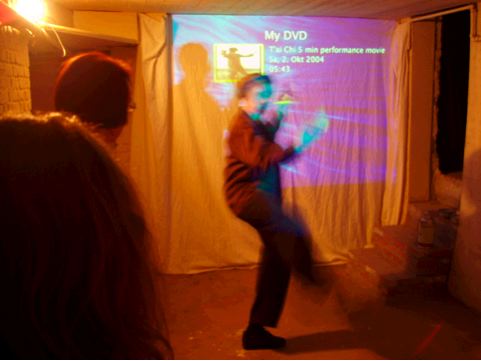
Please talk about the rehearsals and the installing at Factor 44!
The first time we went there we realised that there shouldn't be anything else than the 5 minutes performance in the space, no drawings or photos or whatever, so we just concentrated on the "choreography" because T'ai Chi offers many different possibilities. We also worked a lot to find the right distance and space for Jen's body with regard to the video projector. She had to move within a small area, about 4 square metres, in order to get it right. And the only way to "map" the space was practising over and over again. Fortunately, she also brought 2 of her students to accompany her, and they gave precious advice concerning the choreography, speed, and movements to include. I was more concerned with the visual impact and the relationship to the public. After a while, we worked it out; and we all felt comfortable. We weren't able to do all this with someone less experienced than Jen. The circumstances were quite rough: The darkness and the projector’s light stream right up in your face; only a small space, under a low ceiling, to move within; the necessity to coordinate the movements and the film, and the critical moments of entrance and exit in total darkness…
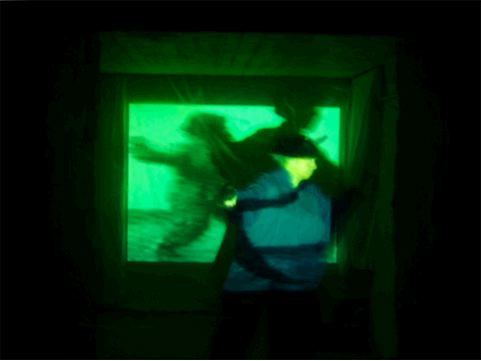
Looking into the other part of the show room, the audience was confronted with the cutting in the wall as a seemingly traditional TV-window. Isn't it a reduction – after all your preparation related to film, photography, drawing, photocopies, sound, movement, exchange… – to exclude an art audience used to experience or even participate in live-performances?
Yes, it is. And it is also the reason why I called the performance "T'ai Chi TV". TV still has this power to make people believe it's the "real thing" they are assisting to by watching TV – which is, of course, false. I was interested in recreating this kind of separation of the senses and of space produced by TV. I remember a performance I saw, called "Coloriage", by the French artist Paul-Armand Gette. It consisted in the colouring of one breast of a young woman, using strawberries. The colouring was made by the artist (who was already over 70 years old at that time) and it took place in a gallery, behind a curtain, so the audience couldn't see the act. But there was a film camera, transmitting the act "live" into a TV in the gallery… To me it was probably the most exciting performance I (n)ever assisted to!


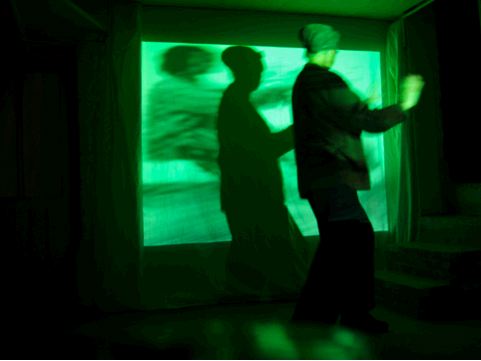
How about your audience's resonance?
I decided that not more than 10 visitors together could enter and be there at a time. (The show was repeated 3 times). So there was actually a kind of "exclusivity" in the air to which the public wasn't used. It wouldn't have made sense to pack the small room full because only 3 persons would have been able to see the show then. Actually, the public had to share this small "TV" and to make place for each other… I welcomed the public downstairs and showed them their space behind the curtain. Then I turned off the light and put on the projection, and Jen entered through a side door, and after 10 seconds the film and the performance started. It lasted exactly 5 minutes, and then Jen disappeared, and I put on the light again and showed the way out. The visitors were pretty impressed by the viewing conditions and by the work. It was unexpectedly beautiful to me… I hadn't been able to think about it so much in visual terms before seeing it and I had totally overseen the third visual element – the shadow. At the end, I heard some negative comments that it was too exclusive and too short, and that some people were frustrated of having to watch through the screen… But hell, that's exactly how I wanted it to be!
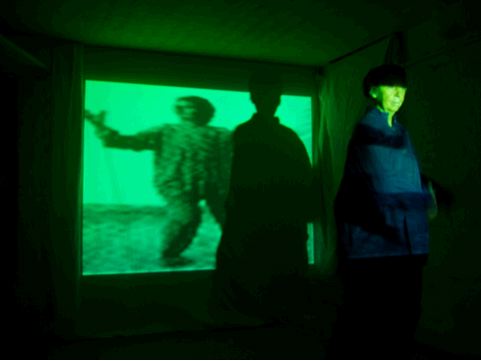
How would you name this kind of artistic research?
Behaviouristic Media Gesamtkunstwerk sounds good to me…
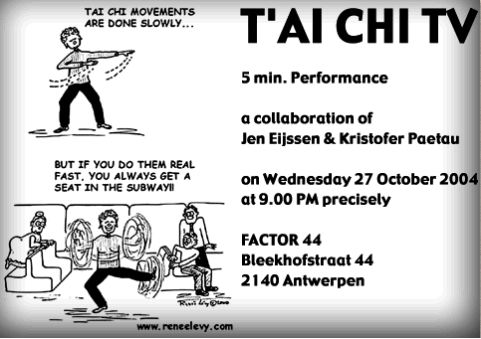
T‘AI CHI TV 5 min. Performance
a collaboration of Jen Eijssen & Kristofer Paetau
on wednesday 27 october 2004 at 9.00 PM precisely
at Factor 44, Bleekhofstraat 44, 2140 Antwerpen
Interview by Heike Wetzig & Kristofer Paetau, october 2004